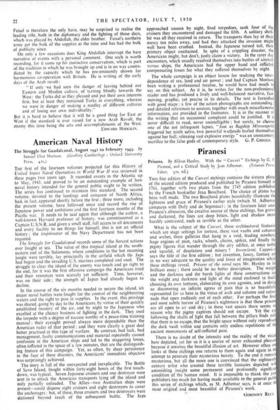Piranesi
Prisons. By Aldous Huxley. With the "Carceri " Etchings by G. P.
l'iranesi, and a Critical Study by Jean Adhemar. (Trianon Press: Faber. 32s. 6d.)
THIS fine edition of the Carceri etchings contains the sixteen plates of the second edition produced and published by Piranesi himself in 1761, together with two plates from the 1745 edition published by the French bookseller Jean Bouchard. The choice of plates has been well made. The two Bouchard plates beautifully illustrate the lightness and grace of Piranesi's earlier style (which M. Adhemar compares with Dufy and de Segonzac) ; in the fourteen later ones Piranesi's obsession, the creative source of these etchings, has grown and darkened, the lines are deep bitten, light and shadow more harshly contrasted, each as terrible as the other.
What is the subject of the Carceri, these architectural fantasies which are stage settings for torture, these vast vaults and column and arches, these galleries that hang in a void, leading nowhere, huge engines of pain, racks,' wheels, chains, spikes, and finally the pigmy figures that wander through the airy edifice, at once noble and squalid, of desolation and misery ? Invenzioni, Cappricei says the title of the first edition ; but invention, fancy, fantasy a in no way adequate to the quality and force of imagination whic these etchings reveal. Prisons of the mind says Mr. Huxley in If brilliant essay ; there could be no better description. The weight and the darkness and the harsh lights of these constructions are the weight and darkness and light of the mind enclosed in itself, choosing its own tortures, elaborating its own agonies, and in doin so discovering an infinite egress of pain that is so beautifull represented for us here in the vistas of arch and column and colon nade that open endlessly out of each other. For 'perhaps the final and most subtle horror of Piranesi's nightmare is that these priso are all open to air and sky ; in these vast spaces there seems n reason why the pigmy captives should not escape. Yet the ey following the shafts of light that fall between the pillars finds onl that there is no escape, that the bright space without only reproduc the dark vault within and contains only endless repetitions of t ancient monuments of self-inflicted pain.
There is no doubt of the intensity and the reality of the visio here depicted, yet for us it is a source of never exhausted pleasu because it assumes the beautiful illusion of art. However often o looks at these etchings one returns to them again and again in t attempt to penerate their mysterious beauty. To the end it remai mysterious, but all the more one is convinced that the eighteent century artist who created these terrible fantasies depicted va astonishing insight some permanent and profoundly significan condition of the human mind. It is impossible to thank the joi publishers too much for having made available to the general pub this series of etchings which, as M. Adhemar says, is at once t most original and most beautiful of Piranesi's work.
GORONVVY REES.






































 Previous page
Previous page